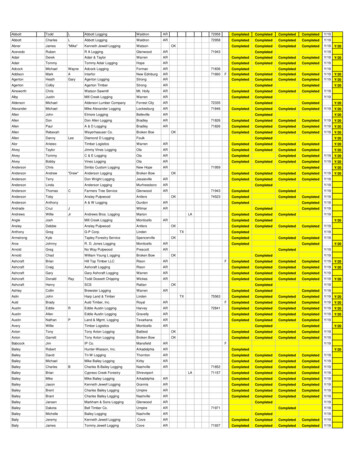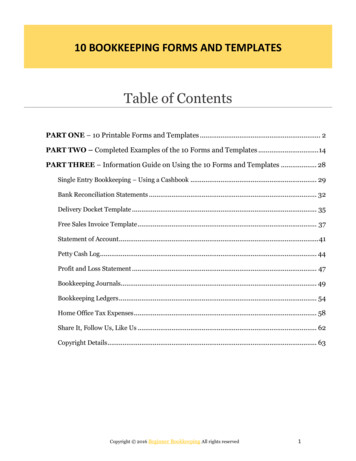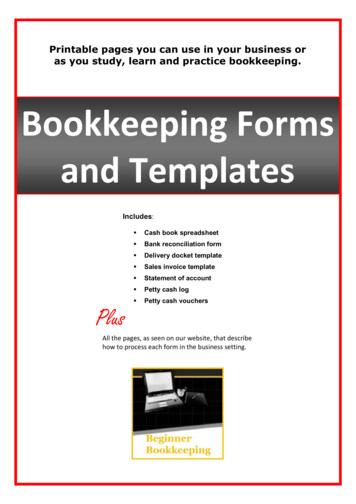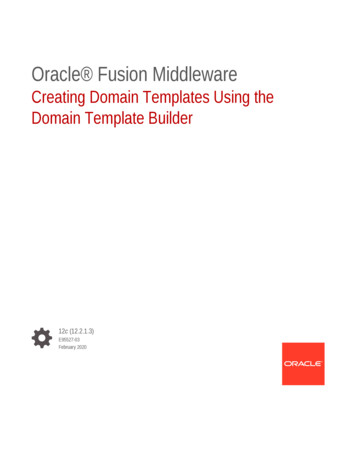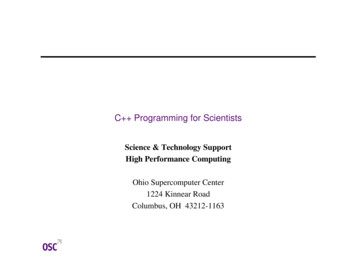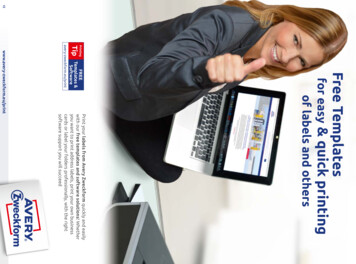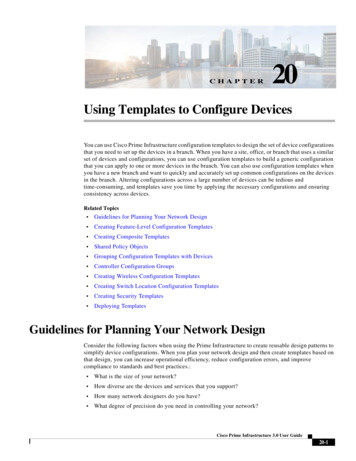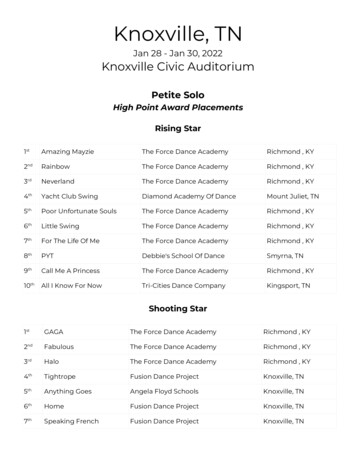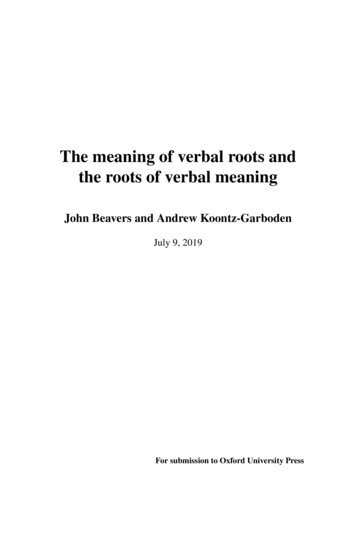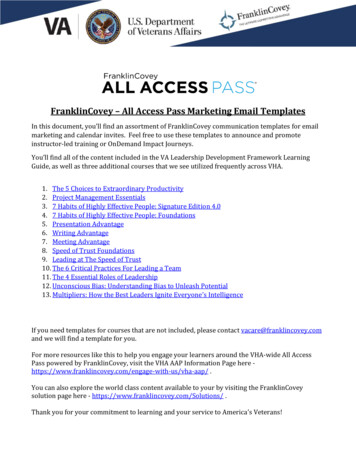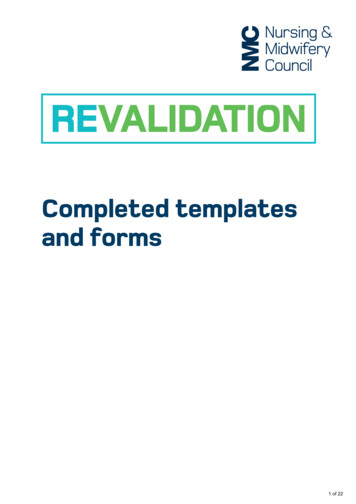
Transcription
Completedtemplatesandforms1 of 22
ContentsThe forms and templates attached are examples of how a nurse ormidwife may record how they meet the requirements of revalidation.Mandatory forms which must be used are marked below (M).These include real life examples taken from nurses or midwives whowent through the revalidation pilot process. This pack includes avariety of reflective accounts designed to reflect multiple practicesettings.1. Practice hours logIndependent sector - Senior nurse manager32. CPD logIndependent sector - Senior nurse manager53. Practice-related feedback log104. Reflective accounts form (M)- Independent sector – senior nurse manager x2- Secondary care – NHS hospital nurse- Occupational health nurse1115175. Reflective discussion form (M)Independent sector - Senior nurse manager196. Confirmation form (M)Independent sector - Senior nurse manager202 of 22
Guide to completing practice hours logWork settingsTo record your hours of practice as a registered nurseand/or midwife, please fill in a page for each of yourperiods of practice. Please enter your most recentpractice first and then any other practice until you reach450 hours. You do not necessarily need to recordindividual practice hours. You can describe yourpractice hours in terms of standard working days orweeks. For example if you work full time, please justmake one entry of hours. If you have worked in a rangeof settings please set these out individually. You mayneed to print additional pages to add more periods ofpractice. If you are both a nurse and midwife you willneed to provide information to cover 450 hours ofpractice for each of these registrations.Dates:Name andaddress oforganisation:Select appropriate setting:Ambulance service Care home sector Care inspectorate Cosmetic/aesthetic sector District nursing Education Governing body or leadership role GP practice or other primary care Health visiting Hospital or other secondary care Insurance/legal Military Occupational healthYour worksettingYour scopeof practice(choose from list above):(choose from list above): Other community servicesOverseasPolicyPrisonPrivate domestic settingPrivate health carePublic healthResearchSchoolSpecialist (tertiary) careTelephone or e-health adviceTrade union or professional bodyVoluntary sectorOtherNumberof hours:YourregistrationYour scope of practice:Commissioning Consultancy Education Management Policy Direct patient care Quality assurance or inspection Registration:Nurse Midwife Nurse/SCPHN Midwife/SCPHNBrief description of your work:(choose from list above):1.1.15 olicyFT 37.5 pw approx1725.perannumNurseGroup Director of Nursing The development of nursingpractice through competencyprogrammes. Identify and implementappropriate CPD training fornurses to develop their skills. Develop a corporate Nursingstrategy. Implementation of the 7Csacross the Group.3 of 22
1.7.96 –currentDistrictnursingDirect patientcareFT 37.5 gementPolicyEducationFT 37.5 pw approxNurse Implementation andmanagement of nurse revalidation.Implementation of animproved clinical supervisionprogramme for nurses.Community nursing1725.perannum1725.perannumNURSEService Line Operations Director To ensure consistency of safenursing practice througheffective Governance,Safeguarding, RiskManagement (clinical andenvironmental), Audit andadapting service delivery topublished NICE guidelines,DoH statutory notices andchanges in legislation. To ensure service users havea positive experience of careby involving them fully in allaspects of service provision.(Please add rows as necessary)4 of 22
Please provide the following information for each learning activity, until you reach 35 hours of CPD (of which 20 hours must be participatory). For examples of the types of CPD activities youcould undertake, and the types of evidence you could retain, please refer to Guidance sheet 3 in How to revalidate with the NMC.Guide to completing CPD record logExamples of learning method Online learningCourse attendanceIndependent learningDates:What was the topic?Link to CodePlease give a brief outline of the key points of thelearning activity, how it is linked to your scope ofpractice, what you learnt, and how you haveapplied what you learnt to your practice.Please identify the part or parts of the Code relevant to the CPD.Prioritise people Practise effectively Preserve safety Promote professionalism and trustMethodTopic(s):Link to Code:Numberofhours:Number ofparticipatory hours:Safe Staffing, Nursing Skill Mix.Looked at tools and concepts forsetting safe staffing levels. Thoughmainly general adult acute, conceptstranslate to mental health. Generated apresentation on key points anddelivered to the Corporate AssuranceCommittee (evidence in online folder)Main learning – actual versus plannedstaffing is irrelevant unless the plannedis correct and includes acuity anddependence not just number of serviceusersPreserve safetyPromoteprofessionalism andtrust63Please describe the methods you used for the activity:27.1.15Safe Staffing / Nursing Skill MixconferenceCourse attendance5 of 22
21.1.15Corporate Leadership ConferenceLeadership across the organisation,people development, strategicdirection, developments,including 1 hour lecture from psychologistPrioritise peoplePreserve safety72Prioritise peoplePractiseeffectivelyPreserve safetyPromoteprofessionalism andtrust63Conference and workshop attendanceCovered number of regional guest speakers& afternoon 2x workshops looking atinnovative practices in the region related todeveloping leaders on the frontline.Corporate Healthcare Conference1 hour presentation on people skillsPrioritise people10Shape of the DoH and impact onindependent sectorPresentation on RevalidationPrioritise peoplePractiseeffectivelyPreserve safetyPromoteprofessionalismand trust22Review on multi agency working, crosscounty boundaries, individual andorganisational responsibility andaccountability, communication.Prioritise peoplePractiseeffectivelyPreserve safety22Conference attendance4.2.1519.2.15Developing Leadership andFacilitation Capacity of the NursingWorkforceConference attendance4.3.15Department of Health IndependentAdvisory ForumWorkshop attendance15.1.14Police Training and ConferenceCentreCourse attendance6 of 22
Promoteprofessionalismand trust3.6.14meeting with CQCMeeting attendance8.7.14Managing risk in mental health unitsin relation to building designConference attendance16.9.14Dashboard Pilot TrainingCourse attendancePresentation by CQC on new ways ofregulating and inspecting.Group breakouts with CQC to tacklespecific issues, problem solve andareas specific to CQCPrioritise peoplePractiseeffectivelyPreserve safetyPromoteprofessional ismand trust33Focused upon the nature of incidents inmental health units, where they occurand why. Insights into the type of workwe can do to reduce risk and wherework can and should be done to reducerisk of harm.Preserve safety10Using key metrics around quality tobetter assess and support delivery ofquality services at a divisional, regionaland site level. Enables triangulation.Preserve safety337 of 22
30.10.14NHS Benchmarking - LearningDisabilities conference - Key findingsand good practice eventCourse attendanceIntroduction to the network and tolearning ismand trust20Understanding baseline processesacross the organisation and divisionaldifferences. Agreeing to participate inpilot with NMCPrioritise peoplePractiseeffectivelyPreserve safetyPromoteprofessionalismand trust22The theme was ‘Inclusion’. TheWorkforce Race Equality StandardPrioritise peoplePractise66Benchmarking ProjectsStrategic direction: Transforming care –home not hospitalsUsing information to drive quality inpatientCareResults of the learning disabilityNHS Benchmarking ProjectDiscussion of Key findings and goodpracticeLeadership in learning disability nursingUsing information to improve the healthof people with learning disabilities13.11.14Nurse Revalidation Workshop14.4.15Regional Directors of NursingConferenceWorkshop attendance8 of 22
Conference attendance(WRES) has been included in thecontract for 2015/16 & the author wasone of the speakers on the day. Alsoupdate on the latest nursing policyissues including amongst a number ofother topics including Revalidation andTransforming Care.effectivelyPreserve safetyPromoteprofessional ismand trustTotal:41Total: 269 of 22
Guide to completing feedback logExamples of sources of feedback Patients or service users Colleagues – nurses midwives, otherhealthcare professionals Students Annual appraisal Team performance reports Serious event reviewsExamples of types of feedback Verbal Letter or card Survey ReportPlease provide the following information for each of your five pieces of feedback. You should not record any information thatmight identify an individual, whether that individual is alive or deceased. Guidance Sheet 1 in How to revalidate with the NMCprovides guidance on how to make sure that your notes do not contain any information that might identify an individual.You might want to think about how your feedback relates to the Code, and how it could be used in your reflective accounts.DateSource of feedbackType of feedbackContent of feedbackWhere did this feedbackcome from?How was the feedbackreceived?What was the feedback about and how has it influenced your practice?1/7/2015StudentVerbal, in a meeting toreview her placementdocumentation10/8/2015Woman I lookedafter on PN wardThank you letterShe found it valuable when I let her take the lead in apostnatal baby check. I will encourage my students to takethe lead more often and try to only provide direction whenthey need it.Linked to ‘promote professionalism and trust’ in the Code.Thanking me for supporting her and her partner throughoutthe discharge process. Highlighted the importance oftaking time to make sure women feel confident andcomfortable before they are sent home.
You must use this form to record five written reflective accounts on your CPD and/or practice-relatedfeedback and/or an event or experience in your practice and how this relates to the Code. Please fill in apage for each of your reflective accounts, making sure you do not include any information that might identifya specific patient, service user or colleague. Please refer to our guidance on preserving anonymity inGuidance sheet 1 in How to revalidate with the NMC.EReflective account: Independent Healthcare Provider – Senior NurseManagerWhat was the nature of the CPD activity and/or practice-related feedback and/orevent or experience in your practice?PLSafe Staffing, Nursing Skill Mix 2015. Looked at tools and concepts for setting safe staffinglevels. Though mainly general adult acute concepts translate to mental health. Series ofpresentations as well as group discussion Q & A .MMain learning – actual versus planned staffing is irrelevant unless the plan is correct andincludes acuity and dependence, not just number of service users. How do we apply tomultiple/diverse service being delivered in environments that are not purpose built?What did you learn from the CPD activity and/or feedback and/or event or experiencein your practice?SAHow safe staffing happens which is Establishment setting / staffing reviewSystematic, consistent approachTriangulateReviewed regularlyFollow best practice guidelines with staff inputPolicy and procedure on rosteringJudgement as well as trainingIf you don’t know what you’ve got, you can’t use itHow did you change or improve your practice as a result?Developed an action plan as follows Rota management - E Rostering Review of staffing establishment by ward from safe perspective Annually and on any change in service or configuration Ward manager training Define organisational red flags / threshold Tools & technology Escalation process Review process Asked Board Sign off11 of 22
How is this relevant to the Code?Select one or more themes: Prioritise people – Practise effectively – Preserve safety –Promote professionalism and trustSAMPLEPromote professionalism and trust12 of 22
You must use this form to record five written reflective accounts on your CPD and/or practice-relatedfeedback and/or an event or experience in your practice and how this relates to the Code. Please fill in apage for each of your reflective accounts, making sure you do not include any information that might identifya specific patient, service user or colleague. Please refer to our guidance on preserving anonymity inGuidance sheet 1 in How to revalidate with the NMC.Reflective account: Independent Healthcare Provider – Senior Nurse ManagerWhat was the nature of the CPD activity and/or practice-related feedbackand/or event or experience in your practice?CPD on 30.7.14. Systematic Investigation training.What did you learn from the CPD activity and/or feedback and/or event or experiencein your practice?I had not previously undertaken any investigation training and over time have beeninvestigating increasingly serious and complex situations involving both staff and serviceusers.I developed a greater understanding of the systematic investigative process and itspractical application to investigate a wide range of incidents, including patient-safetybreaches, complaints, non-clinical events and professional misconduct or capabilityconcerns. Also to understand how an investigation can be used to discover why an incidentoccurred and identify solutions to prevent similar incidents happening again.How did you change or improve your practice as a result?Shortly after completing the training I had to lead an investigation panel into the suicide of aservice user within 48 hours of discharge. I was able to use the new skills and tools tobetter organise the information available. This was particularly beneficial in organising thechronology. I was able to put into practice interviewing skills with the nursing staff whostated they could not recall the service user. As a consequence the investigation andsubsequent report felt more competed and detailed that previous investigations and therecommendations were more comprehensive. I had increased confidence in leading thepanel. Below are the aspects of the training that I was able to practically apply to my work : human error theorycommissioning and setting terms of referencesecuring and collating written evidenceinvestigative tools and modelsestablishing a comprehensive chronologyanalysing dataWriting the report and developing recommendations that are specific, measurable,achievable, relevant and timescaled (SMART).13 of 22
How is this relevant to the Code?Select one or more themes: Prioritise people – Practise effectively – Preserve safety –Promote professionalism and trust Practice effectivelyPreserve safetyPromote professionalism and trust14 of 22
You must use this form to record five written reflective accounts on your CPD and/or practice-relatedfeedback and/or an event or experience in your practice and how this relates to the Code. Please fill in apage for each of your reflective accounts, making sure you do not include any information that might identifya specific patient, service user or colleague. Please refer to our guidance on preserving anonymity inGuidance sheet 1 in How to revalidate with the NMC.Reflective account: Secondary Care – NHS hospital nurseWhat was the nature of the CPD activity and/or practice-related feedbackand/or event or experience in your practice?CPD participatory activity – Attending a Manual Handler Transfer Specialist course.What did you learn from the CPD activity and/or feedback and/or event orexperience in your practice?As an experienced community nurse I have had to adapt to various environments to delivercare safely and effectively. Working within the community team we are involved in providingcare for patients with complex health care needs at home, most presenting with limitedability to mobilise and transfer independently. I was approached by the lead ANP toparticipate in the manual handling transfer specialist training course to help develop theteam’s knowledge and skills in patient handling safely and effectively. The role of transferspecialist will also promote the team’s compliance with the Trusts mandatory trainingprogramme.The startling statistics highlighting that 24% of NHS staff are injured through poor manualhandling practice and contributes to 40% of sickness and absence emphasises the need forraising awareness of the consequences of poor practice. The cost to the NHS forcompensation claims is approximately 150million a year, money that should go directly topatient care.The role of transfer specialist will focus on organisational and individual training needs tocontinue to move safer handling practice forward across the organisation in line with currentbest practice. Each trainer will be expected to attend a minimum of one update trainingsession every year facilitated by a board manual handling advisor.Standards for training staff entail completing a structured manual handling passport and theassessment of staff members involves carrying out practical modules relevant to theirworkplace. For new staff an induction will be carried out and a checklist of training needsmust be met prior to commencement of work. Self-assessments will be carried out every 2years and training if required provided by the transfer specialist.15 of 22
The various legislation regarding risk assessments and safety at work were discussed andthe importance of assessment prior to performing any task was reinforced, with the aim toreduce risk of injury to both patient and staff memberHow did you change or improve your practice as a result?Along with another team member we have arranged a teaching programme which includesindividual task assessments, control measures, risk assessments, care plans that aresuitable and review dates. We have offered support in accompanying colleagues on homevisits to carry out complex assessments which enables us to initiate safer handlingprinciples. We will act as a resource to the team in relation to the ordering of equipmentwith the purpose of reducing the risk of injury to colleagues and patients as a result of poormanual handling practiceHow is this relevant to the Code?Select one or more themes: Prioritise people – Practise effectively – Preserve safety – Promoteprofessionalism and trustAll 4 themes of the NMC Code are linked to this CPD activity:Prioritise people - the majority of people referred to the CRT are older with chroniclimitations including social needs. In order for some patients to remain at home safelyfunctional assessments are necessary to perform the fundamentals of care safely. Theextended knowledge and skills in identifying appropriate aids such as hoists for transferringpatients enables those individuals to have a choice to remain independent with formalsupport at home.Practise effectively – the ongoing manual handling updates enables staff members tomaintain their knowledge and skills needed for safe and effective practice.Preserve safety – As a transfer specialist I am to be a resource for the team, supportingcolleagues to take account of their own personal safety as well as patient safety byattending manual handling training sessions.Promote professionalism and trust - I intend to be a model of integrity and leadership bybeing committed to the standards of safer handling practice.16 of 22
You must use this form to record five written reflective accounts on your CPD and/or practice-relatedfeedback and/or an event or experience in your practice and how this relates to the Code. Please fill in apage for each of your reflective accounts, making sure you do not include any information that might identifya specific patient, service user or colleague. Please refer to our guidance on preserving anonymity inGuidance sheet 1 in How to revalidate with the NMC.Reflective account: Occupational health nurseWhat was the nature of the CPD activity and/or practice-related feedbackand/or event or experience in your practice?Annual appraisal discussion with my line manager – health & safety manager. Irated each of my objectives and my line manager agreed on the rating andsuggested an upgrade to one of the objectives on ‘healthy company’.The most constructive feedback was how to manage my head of department whodoes like to get involved with lots of initiatives and then needs me to provideinformation, advice and support on top of day job.The organisation has an online performance management system that is completedby the employee, reviewed by the manager and allows for comments onperformance as part of end of year discussion.The discussion lasted about 45 minutes and we ran through each of the objectives,what has been achieved and how it was achieved. We then reviewed mycompetencies against the Competency Framework, reflecting on current andrequired level. Any gaps would then form part of ongoing development. We alsodiscussed the development plan and agree learning needs.What did you learn from the CPD activity and/or feedback and/or event orexperience in your practice?I have a lot of work to do and need to close out the systems work I have been doingto start concentrating more time on the three key projects that have been identifiedfor occupational health of the next 2-3 yearsFinally I have learnt how to more effectively manage the expectations of our Headof Department, in terms of my time and ability to deliver on the priorities. He doestake push back well and usually allows me to make the final decision ie mentalhealth providers, implementing health assessment standards and working with thealcohol network.How did you change or improve your practice as a result?I developed my skills in the area of audit; air quality and fatigue through theattendance at courses, conferences and self-directed learning.17 of 22
Audit – ISO 9001 Lead Auditor course. Part of internal audit team –developed tools and new style of deliveryAir quality – conducted research, reviewed external technical researchproject, lead working group developing good practice guideFatigue – conducted research, lead small-scale research project andprovided feedback and advice.How is this relevant to the Code?Select one or more themes: Prioritise people – Practise effectively – Preserve safety – Promoteprofessionalism and trustThe related to all four themes;1. Prioritise people – I put great credence on the personal developmentprogramme as it provides formal feedback and helps me understand needsand try to deliver.2. Practise effectively – provides an opportunity to identify areas forimprovement and development activities3. Preserve safety – able to discuss gaps in knowledge and seek advice andsupport on filling those gaps4. Promote professionalism – conducting myself professionally in the reflectivediscussion, choosing my words appropriately and linking my work objectiveswith those of my profession.18 of 22
19 of 22
20 of 22
21 of 22
22 of 22
Safe Staffing / Nursing Skill Mix conference ; Course attendance Safe Staffing, Nursing Skill Mix. Looked at tools and concepts for setting safe staffing levels. Though mainly general adult acute, concepts translate to mental health. Generated a presentation on key points and delivered to the Corporate Assurance Committee (evidence in online .
